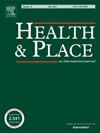Food retail environments around rural Victorian primary Schools: Associations with student diet and weight outcomes
IF 4.1
2区 医学
Q1 PUBLIC, ENVIRONMENTAL & OCCUPATIONAL HEALTH
引用次数: 0
Abstract
Few studies examine the influence on population diets of the healthiness of food retail outlets in the areas surrounding rural schools in Australia. This exploratory cross-sectional study examined associations between food retail environments within 500m and 1 km of 106 primary schools in rural Victoria, Australia, and self-reported diet and measured weight status of grade 4(9-10yo) and grade 6(12-13yo) students (n = 3236). Few significant results were found with a 500m network buffer. At 1 km, there were reduced odds of meeting sugar sweetened beverage (SSB) recommendations with more unhealthy (OR: 0.51, 95 %CI 0.26, 0.98) or takeaway outlets (OR: 0.58, 95 % CI 0.37, 0.89), compared to none of these outlets. Compared to having no supermarkets, the presence of more supermarkets was associated with higher odds of meeting unhealthy snack recommendations (OR: 2.19 95 %CI 1.28, 3.76), SSB recommendations (OR: 1.96 95 % CI 1.23, 3.13) and reduced odds of having overweight or obesity (OR: 0.75 95 %CI 0.57, 0.99). Further investigation into the impact of the food outlet placement on children's dietary behaviours is warranted, in order to inform policy regarding the placement of outlets in proximity of schools.
维多利亚州农村小学周围的食品零售环境:与学生饮食和体重结果的关系
很少有研究调查澳大利亚农村学校周边地区的食品零售店对人口饮食健康的影响。本探索性横断面研究考察了澳大利亚维多利亚州农村106所小学500米至1公里范围内的食品零售环境与四年级(9-10岁)和六年级(12-13岁)学生自我报告的饮食和测量体重状况之间的关系(n = 3236)。对于500m的网络缓冲区,几乎没有发现显著的结果。在1公里处,满足含糖饮料(SSB)建议的几率较低,有更多不健康(OR: 0.51, 95% CI 0.26, 0.98)或外卖店(OR: 0.58, 95% CI 0.37, 0.89)。与没有超市相比,超市越多,满足不健康零食建议(OR: 2.19 95% CI 1.28, 3.76)、SSB建议(OR: 1.96 95% CI 1.23, 3.13)和超重或肥胖的几率就越低(OR: 0.75 95% CI 0.57, 0.99)。有必要进一步调查食品销售点的设置对儿童饮食行为的影响,以便为有关在学校附近设置食品销售点的政策提供信息。
本文章由计算机程序翻译,如有差异,请以英文原文为准。
求助全文
约1分钟内获得全文
求助全文
来源期刊

Health & Place
PUBLIC, ENVIRONMENTAL & OCCUPATIONAL HEALTH-
CiteScore
7.70
自引率
6.20%
发文量
176
审稿时长
29 days
期刊介绍:
he journal is an interdisciplinary journal dedicated to the study of all aspects of health and health care in which place or location matters.
 求助内容:
求助内容: 应助结果提醒方式:
应助结果提醒方式:


